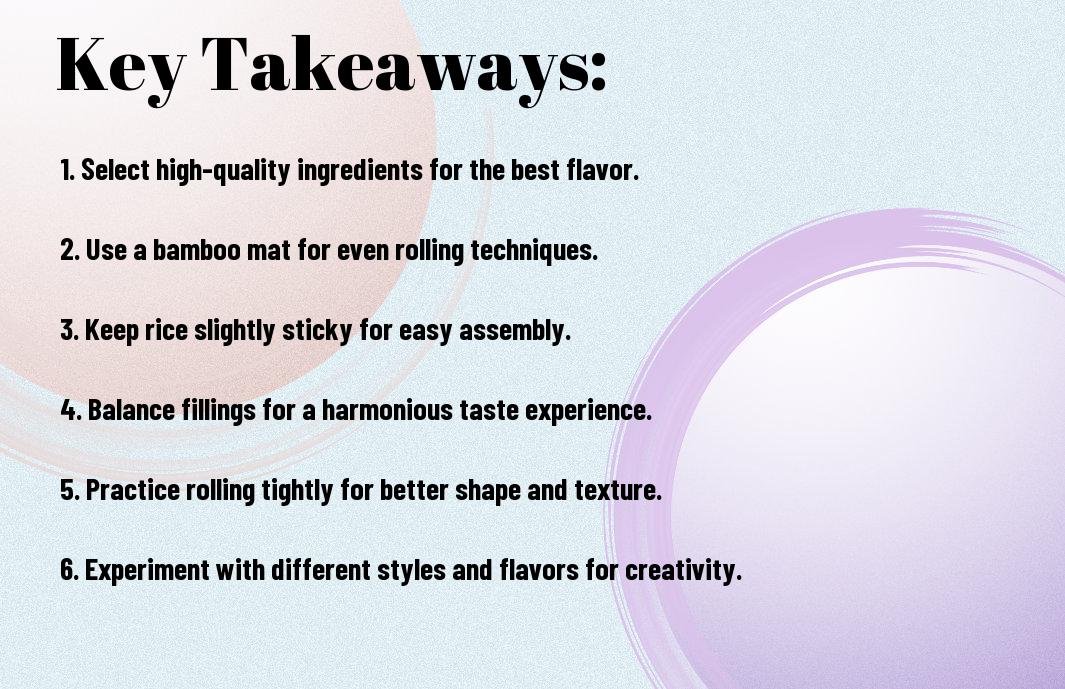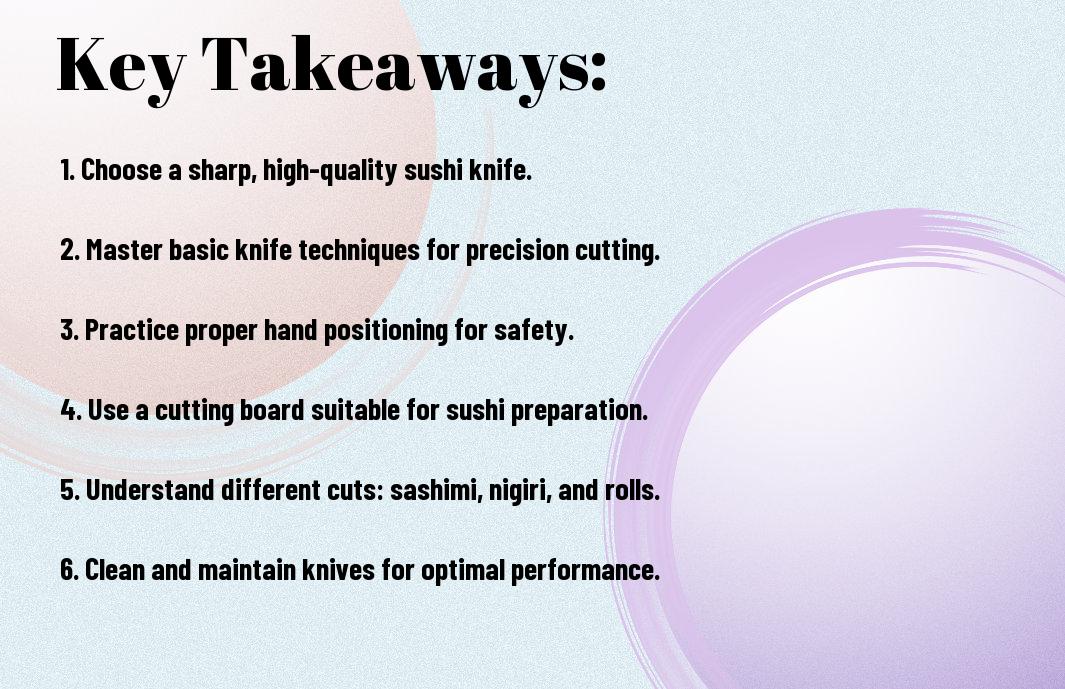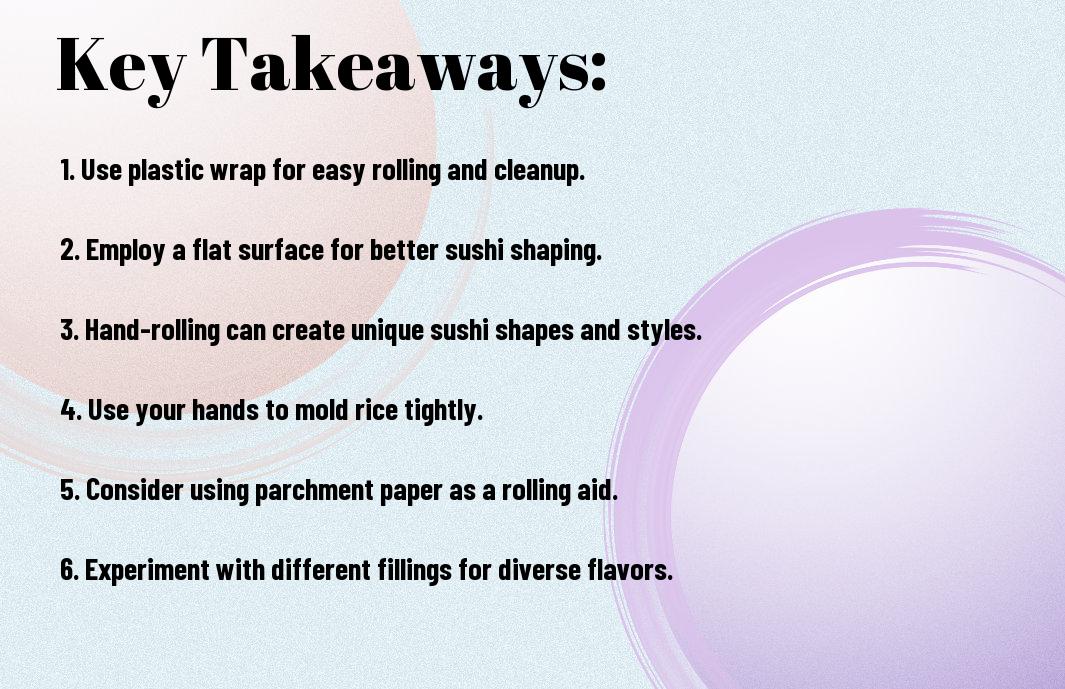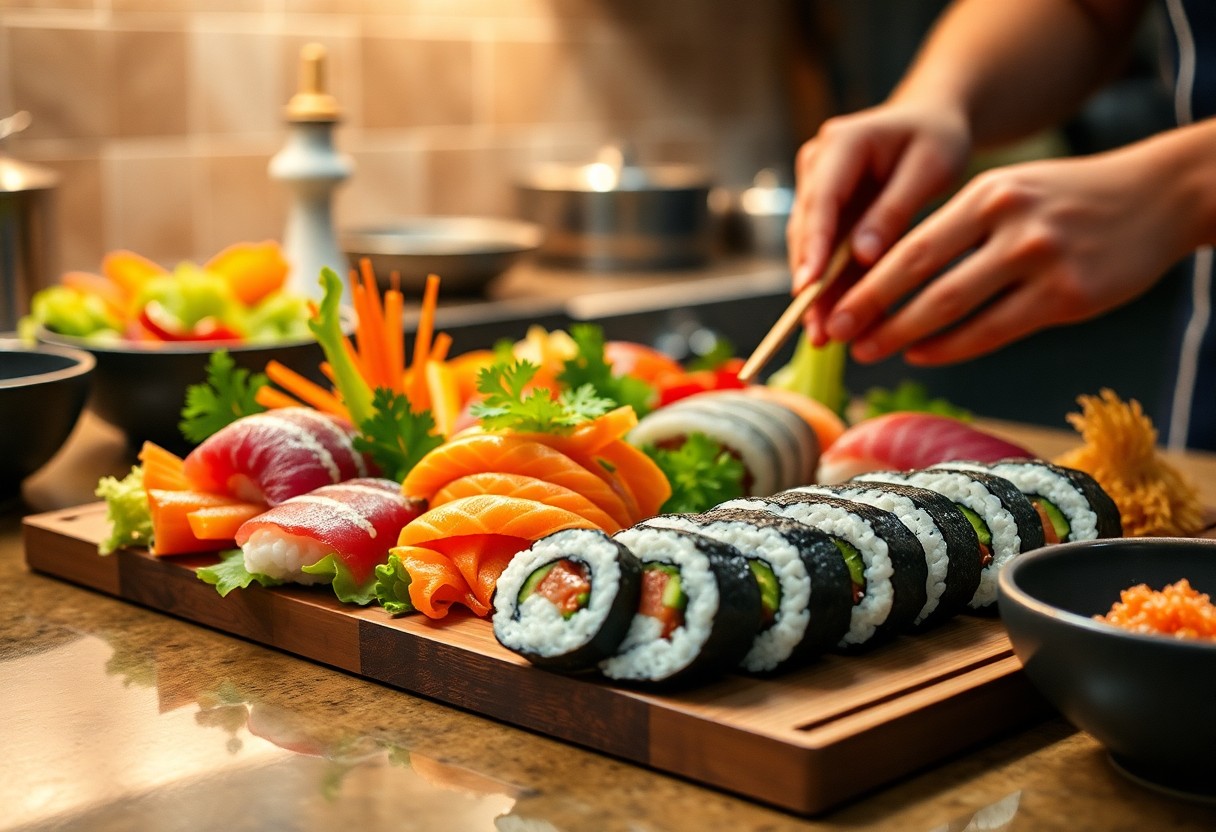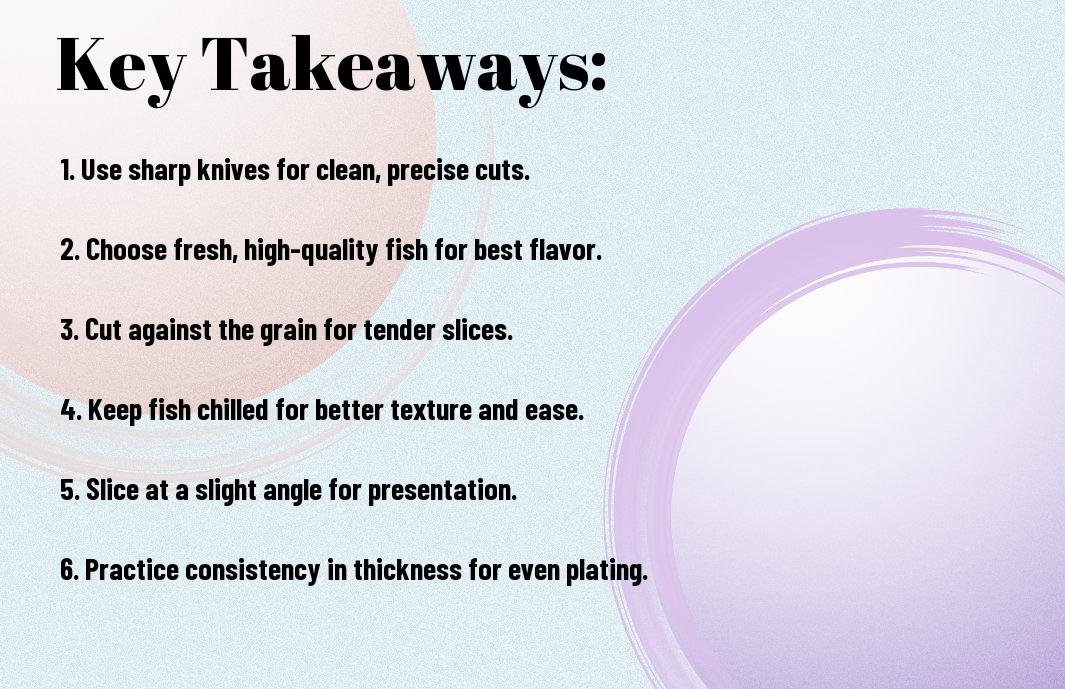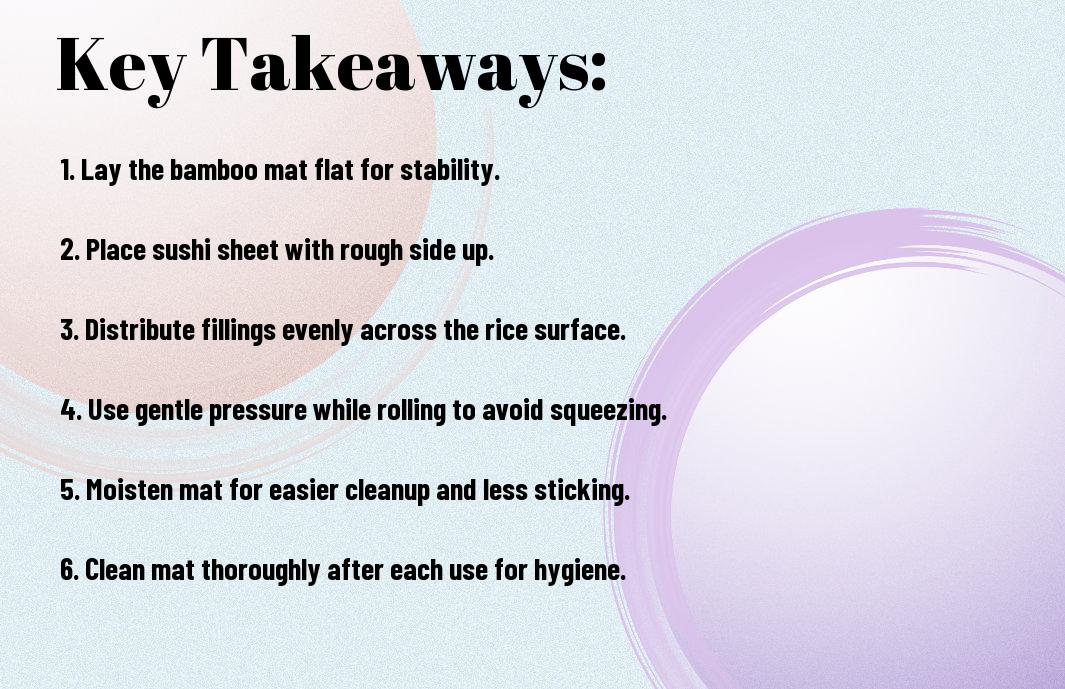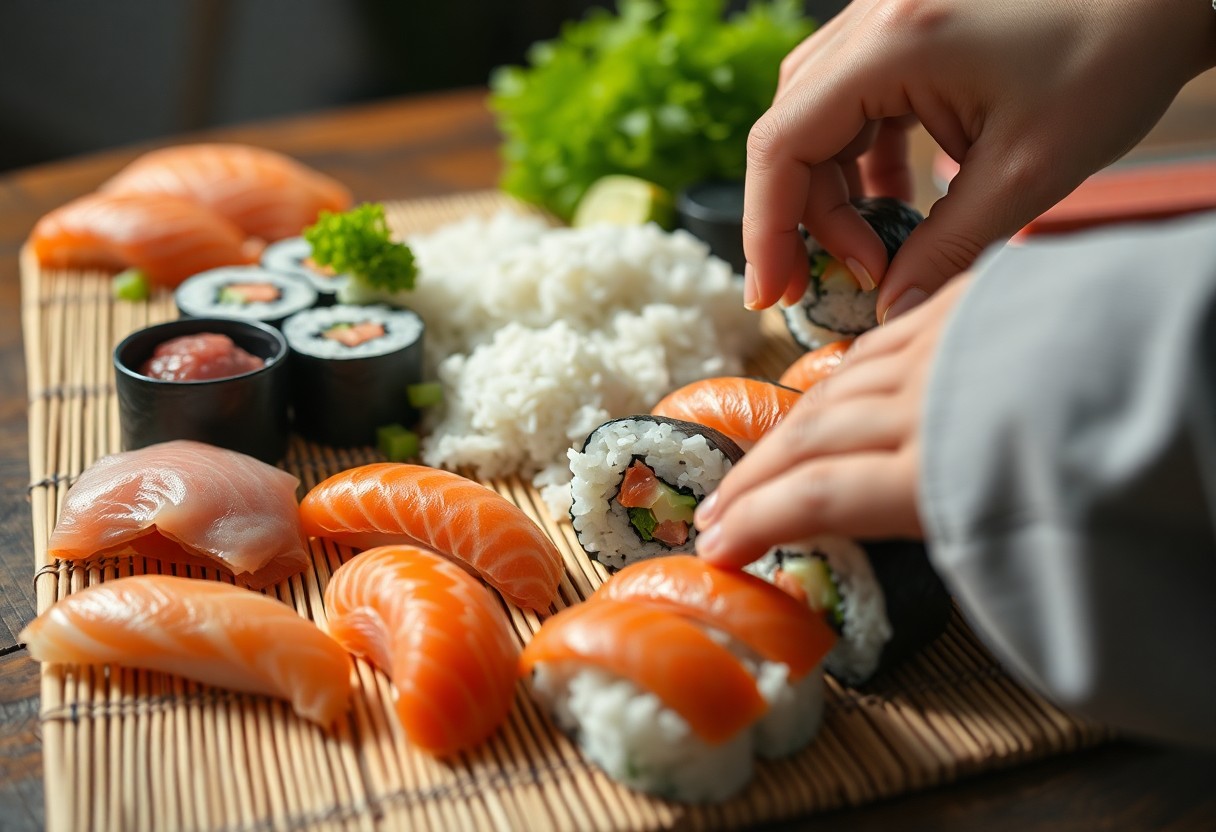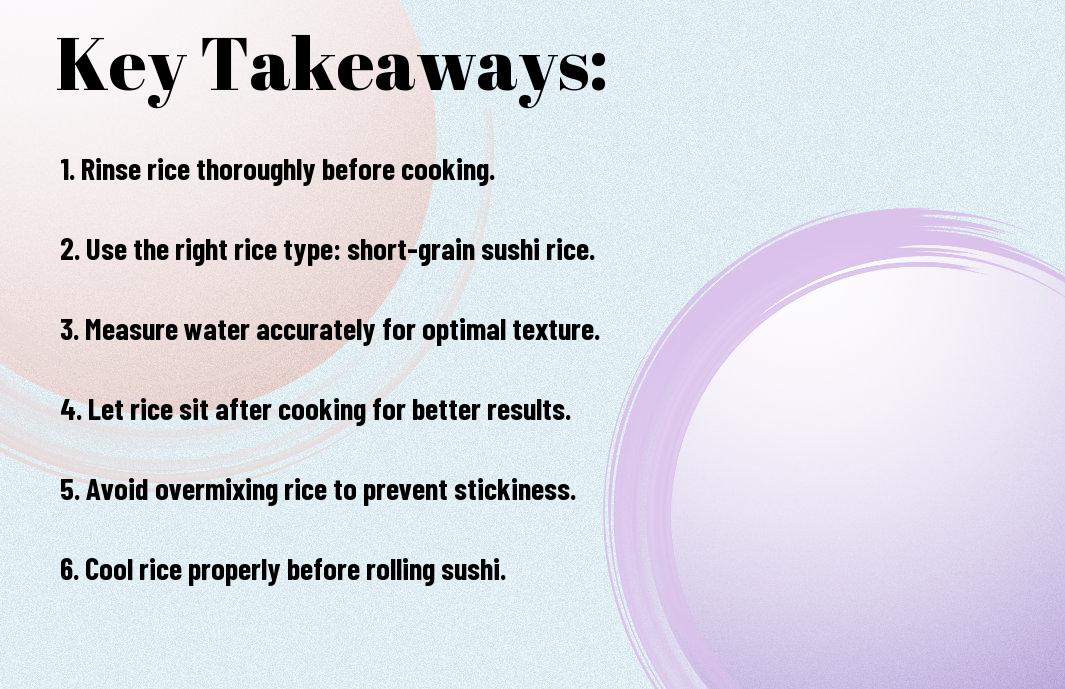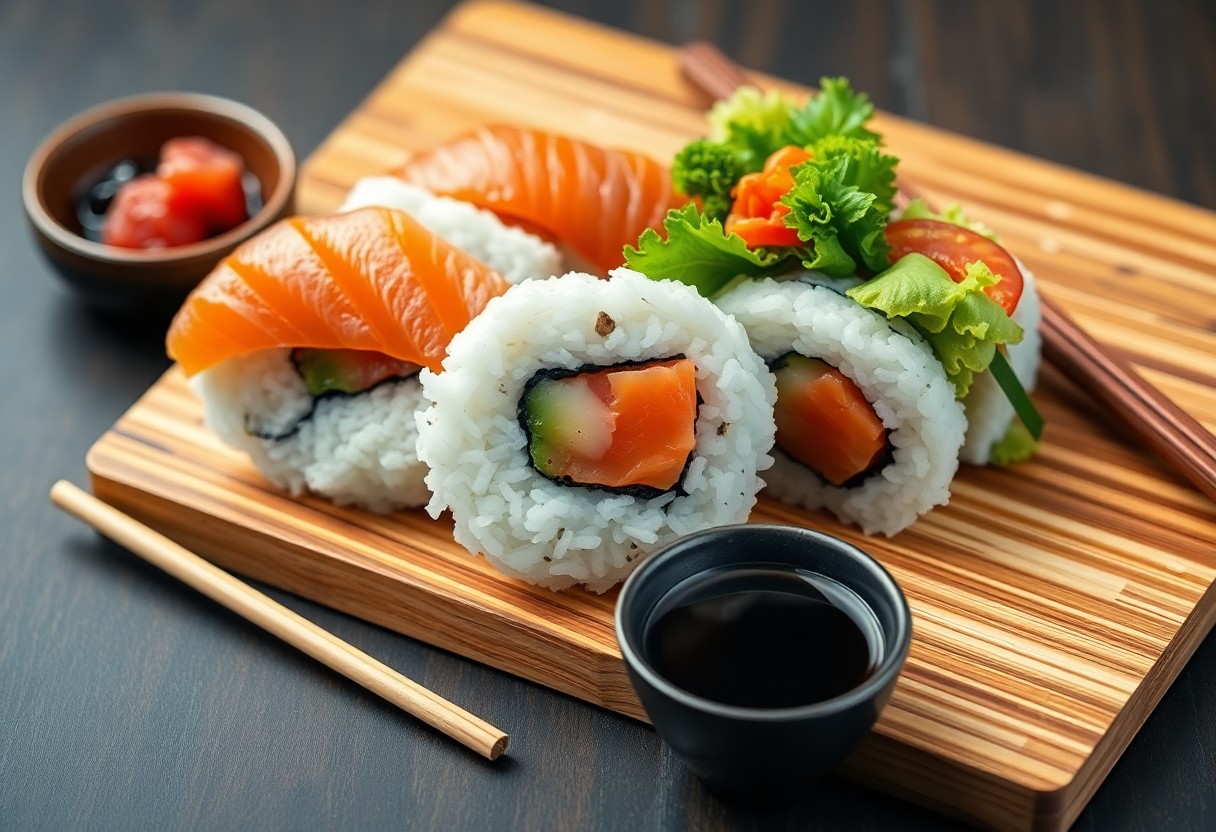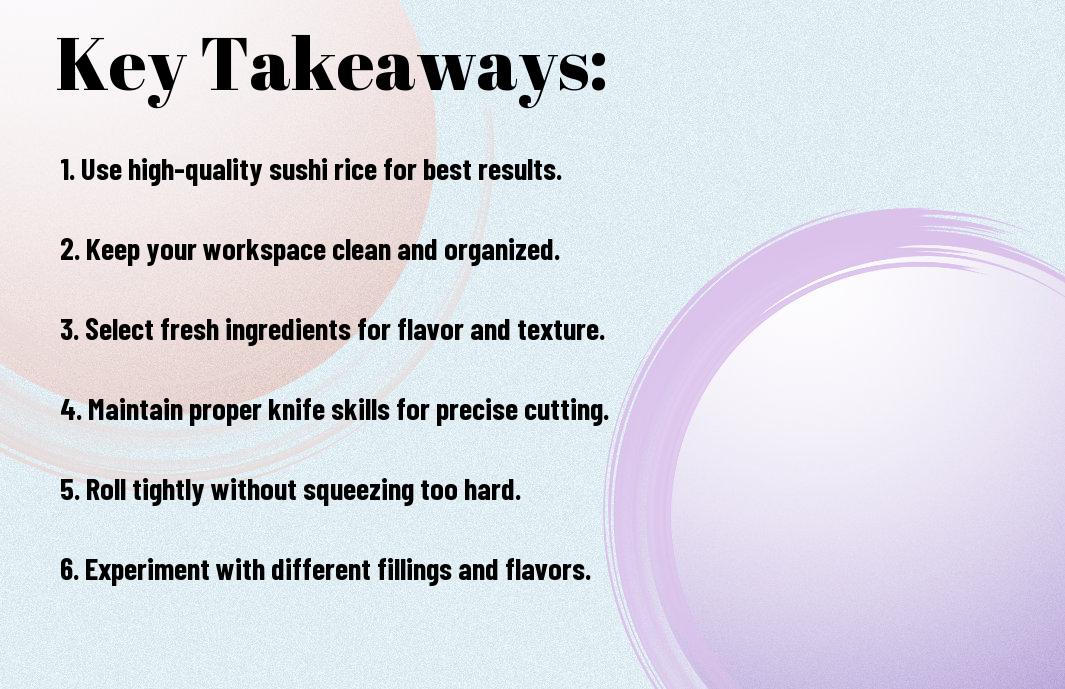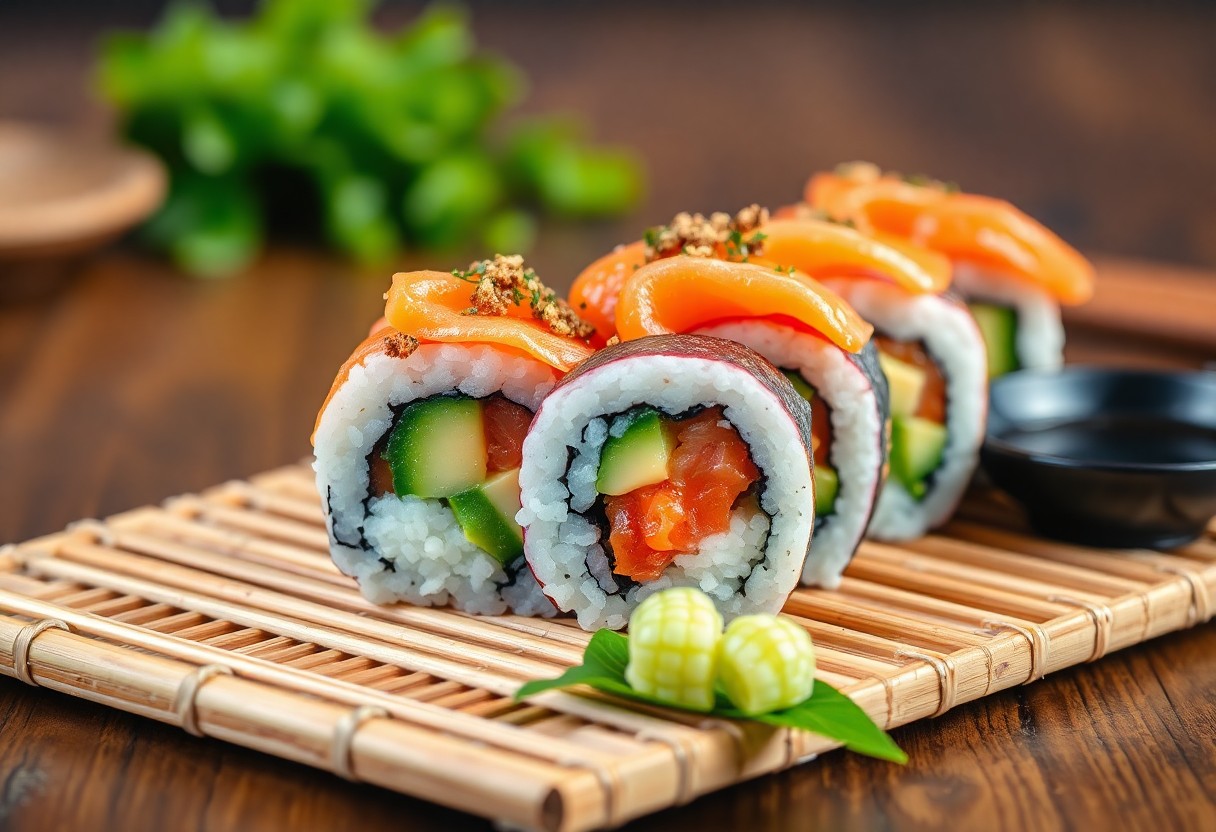With a vibrant mix of flavors, textures, and traditions, sushi has captivated food lovers around the globe. In this exploration of sushi making, you will examine into the meticulous processes that transform simple ingredients into beautiful and delicious rolls. From selecting the finest fish to mastering the techniques of rice preparation, your journey will reveal the artistry and cultural significance behind each dish. Prepare to enhance your appreciation for this culinary tradition as you learn how your favorite sushi is crafted step by step.
Key Takeaways:
- Ingredients: Freshness is necessary; high-quality fish and rice are the foundation of great sushi.
- Preparation: Each ingredient must be prepared with care; techniques such as slicing fish and seasoning rice are critical.
- Rolling Technique: The art of rolling sushi requires skill; mastering the balance of ingredients and the right pressure is key.
- Presentation: Aesthetic appeal is important; sushi must look inviting and beautiful on the plate.
- Culture: Sushi making involves traditional practices; understanding its history adds depth to the dining experience.
The History of Sushi
While sushi has become a beloved global cuisine, its history is rich and complex. Originating from Japan, sushi began as a method of preserving fish in fermented rice. Over time, sushi evolved into the various delicious forms you know today, each with its own unique techniques and presentations. For a deeper probe the different types and styles, check out Sushi Making Styles Explained: Nigiri, Maki, Hand Rolls ….
Origins of Sushi
Among the earliest records of sushi can be traced back to Southeast Asia, where fish was preserved using fermented rice. This method, known as narezushi, was practical for long journeys, providing nourishment without refrigeration.
Evolution Through the Ages
After the introduction of sushi to Japan, its preparation and presentation began to evolve significantly. The process shifted from preservation to a focus on flavor and artistry, leading to the creation of various styles that cater to diverse tastes.
For instance, during the Edo period, sushi transformed into a fast food, with the invention of nigiri-zushi—hand-formed rice topped with fresh fish. This marked a significant shift towards contemporary sushi that you enjoy today. As sushi traveled throughout Japan, regional variations emerged, reflecting local ingredients and preferences. This evolution has shaped sushi into a globally recognized cuisine, admired for both its artistry and flavor. Understanding this history enriches your sushi experience, whether you’re dining out or making it at home.
Ingredients of Sushi
It is imperative to understand the key components that make up sushi to appreciate the artistry behind each roll. Freshness and quality are the cornerstones of sushi ingredients, often encompassing a mix of seafood, vegetables, and seasoned rice. For a deeper investigate the intricacies involved in “The Fine Art of Making Sushi,” you can check out this resource here.
Rice: The Foundation
An imperative part of sushi is rice, which serves as the foundation for every roll. Short-grain sushi rice is commonly used, as its sticky texture allows it to hold together perfectly when rolled. You’ll find that it’s typically seasoned with a mixture of rice vinegar, sugar, and salt, providing that delightful balance of sweetness and tang that perfectly complements your filling.
Seafood and Vegetables
Among the highlights of sushi are the seafood and vegetables that add flavor and vibrancy. You have the option to work with a plethora of fresh ingredients like tuna, salmon, shrimp, or seasonal vegetables, all chosen based on your personal taste and the seasonality of ingredients.
Considering the variety available, selecting the right seafood and vegetables can elevate your sushi game immensely. Freshness is key, as high-quality fish and crisp, vibrant veggies enhance taste and texture. When crafting your sushi, aim for a harmonious balance that not only brings out the natural flavors of individual components but also creates a delightful experience with each bite. Opting for seasonal varieties ensures that your sushi is not only delicious but also visually appealing.

Sushi Preparation Techniques
To create exceptional sushi, mastering the preparation techniques is crucial. Each step, from rice cooking to fish slicing, contributes to the final dish’s flavor and presentation. These techniques require practice and attention to detail, allowing you to fully appreciate the artistry behind sushi making. By focusing on these fundamentals, you can elevate your skills and impress your guests with beautifully crafted rolls.
Rice Cooking and Seasoning
Preparation of sushi rice entails washing and rinsing the grains thoroughly to remove excess starch, ensuring a fluffy texture. Once cooked, the rice is mixed with a seasoned vinegar solution, which balances sweetness and acidity. This process not only enhances the flavor but also gives the rice a glossy finish, making it the perfect foundation for your sushi.
Fish Preparation and Slicing
Rice preparation serves as the backbone of sushi, but the fish you choose can significantly impact the overall taste. Proper fish preparation involves selecting the freshest options, ensuring they are clean and safe to eat. Techniques for slicing vary based on the type of fish and the desired presentation, as you will want to achieve thin, consistent cuts that enhance both flavor and texture.
Consequently, mastering the art of fish preparation and slicing allows you to elevate your sushi experience. Techniques such as the ‘tataki’ or ‘sashimi’ cuts draw out the fish’s natural flavors while maintaining an aesthetically pleasing look. With practice, you’ll learn to handle various fish types, ensuring each slice showcases your culinary skills and passion for sushi-making.
Types of Sushi
Not all sushi rolls are created equal! You can explore a delightful array of sushi varieties, each offering unique flavors and presentations. Here’s a brief overview:
- Nigiri
- Maki
- Temaki
- Sashimi
- Uramaki
The variations in sushi types enable you to choose your favorites and expand your palate.
| Type of Sushi | Description |
|---|---|
| Nigiri | Hand-formed sushi topped with a slice of fish or seafood. |
| Maki | Rolled sushi with various fillings wrapped in seaweed and rice. |
| Temaki | Hand-rolled sushi cone filled with ingredients. |
| Sashimi | Sliced raw fish served without rice. |
| Uramaki | Inside-out sushi roll with rice on the outside. |
Nigiri
Behind the simplicity of nigiri lies its elegance. You find that nigiri consists of a small mound of vinegared rice topped with a slice of fish or seafood. The balance of flavors is paramount, as the rice’s slight sweetness complements the umami of the chosen topping. As you indulge, you’ll appreciate the skill involved in forming the rice and selecting the freshest ingredients.
Maki and Temaki
Temaki rolls offered an interactive experience as you roll your sushi by hand. Maki, traditionally rolled in a bamboo mat, includes various ingredients mixed with sushi rice, creating a delightful burst of flavors with each bite.
Due to the creativity involved in crafting both maki and temaki, you can personalize your sushi experience with diverse fillings and toppings. Popular maki features include cucumber, crab, and avocado. Temaki allows you to assemble your favorite ingredients, making each roll unique. Your sushi journey can be as traditional or innovative as you desire.
Sushi Presentation
Now that you’ve explored the intricate process of sushi making, let’s investigate the presentation aspect, which plays an crucial role in sushi dining. A beautifully presented sushi platter not only enhances the visual appeal but also elevates the overall dining experience. The way sushi is arranged can create a feast for the eyes, setting the mood and anticipation for what’s to come.
Aesthetic Considerations
At the heart of sushi presentation is the understanding of aesthetics. You should consider colors, shapes, and balance while arranging sushi on the plate. Vibrant hues of fresh fish and vegetables contrast beautifully against simple white or dark plates, drawing attention to your culinary art. You’ll want to create a harmonious arrangement that encourages the viewer’s eye to wander without overwhelming them.
Plating and Garnishes
Sushi can be elevated through thoughtful plating and the use of garnishes. The arrangement of sushi, whether in rows, stacks, or decorative patterns, can significantly impact the dish’s overall appeal. By incorporating garnishes, you introduce an artistic touch that complements the sushi itself.
Garnishes play an important role in enhancing both the visual and flavor profiles of your sushi presentation. You can use elements like thinly sliced radish, microgreens, or edible flowers for an artistic flair. These add-ons not only make your sushi platter more appealing but also offer additional textures and flavors that enrich your dining experience. The right garnishes can surprise your guests, making your sushi not just a meal, but an artwork to savor.
Cultural Significance of Sushi
After centuries of evolution, sushi has transcended its humble beginnings to become a symbol of Japanese culture and an expression of artistry. In Japan, it represents not just a meal but a way to appreciate nature’s offerings through seasonal ingredients. The meticulous preparation and presentation of sushi reflect deep respect for tradition, highlighting the importance of craftsmanship and community in Japanese society.
Sushi in Japanese Tradition
Across Japan, sushi has been a communal experience, often enjoyed during celebrations and family gatherings. It embodies harmony and balance, which are deeply ingrained in Japanese aesthetics and philosophy. Using fresh, local ingredients fosters a connection to the land, allowing you to engage in a centuries-old practice that celebrates the essence of nature.
Global Influence and Adaptation
At the same time, sushi has evolved into a global phenomenon, with chefs worldwide experimenting with flavors and presentations. As you savor sushi in different cultures, you can discover a variety of interpretations that blend traditional elements with local ingredients, showcasing the versatility of this culinary art.
Consequently, sushi has adapted into countless forms, from California rolls to sushi burritos, appealing to diverse palates and preferences. This fusion highlights how global influences can reshape traditional cuisine, allowing you to experience sushi in ways you might not have anticipated. With each bite, you partake in a culinary journey that pays homage to its origins while celebrating innovation and creativity.
Conclusion
With these considerations in mind, you can appreciate the intricate process behind making sushi and the craftsmanship involved in each roll. From selecting the finest ingredients to mastering the delicate techniques of preparation, every aspect contributes to the overall experience. As you explore sushi-making or enjoy a meal at a restaurant, you’ll gain a deeper respect for the art that transforms simple ingredients into a culinary masterpiece that delights your palate.
Q: What ingredients are typically used in making sushi?
A: Sushi is crafted using a variety of fresh ingredients, with one of the primary components being sushi rice, which is seasoned with rice vinegar, sugar, and salt. Other common ingredients include raw fish such as tuna or salmon, vegetables like cucumber and avocado, and nori (seaweed sheets) for rolling. Optional accompaniments include wasabi, soy sauce, and pickled ginger, which enhance the flavors of the sushi.
Q: Can you explain the different types of sushi?
A: Certainly! There are several popular types of sushi, each with its own unique characteristics. Nigiri consists of a small mound of sushi rice topped with a slice of fish or seafood. Maki is rolled sushi, where ingredients are wrapped in rice and seaweed, and can be further categorized into hosomaki (small rolls) and uramaki (inside-out rolls). Sashimi, on the other hand, is thinly sliced raw fish without rice. Finally, temaki is hand-rolled sushi shaped like a cone and filled with various ingredients.
Q: What is the process behind making sushi rice?
A: Making sushi rice involves a few important steps. First, high-quality short-grain rice is rinsed multiple times to remove excess starch, ensuring the rice becomes sticky when cooked. The rice is then cooked in a rice cooker or pot with a specific water-to-rice ratio. Once cooked, the rice is transferred to a wooden or plastic container, where a mixture of rice vinegar, sugar, and salt is gently folded into the rice while fanning it to cool. This process gives sushi rice its signature flavor and texture, making it integral to creating delicious sushi rolls.
